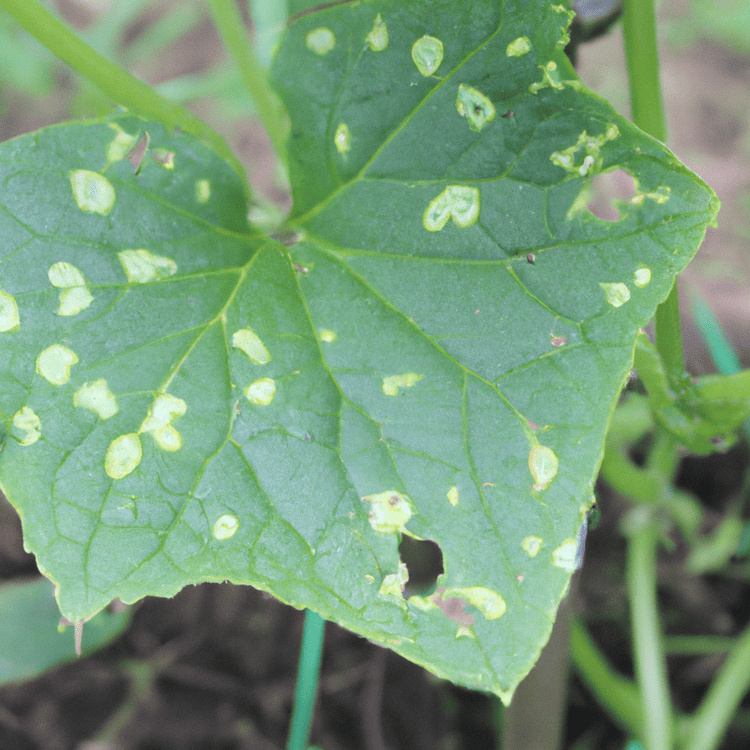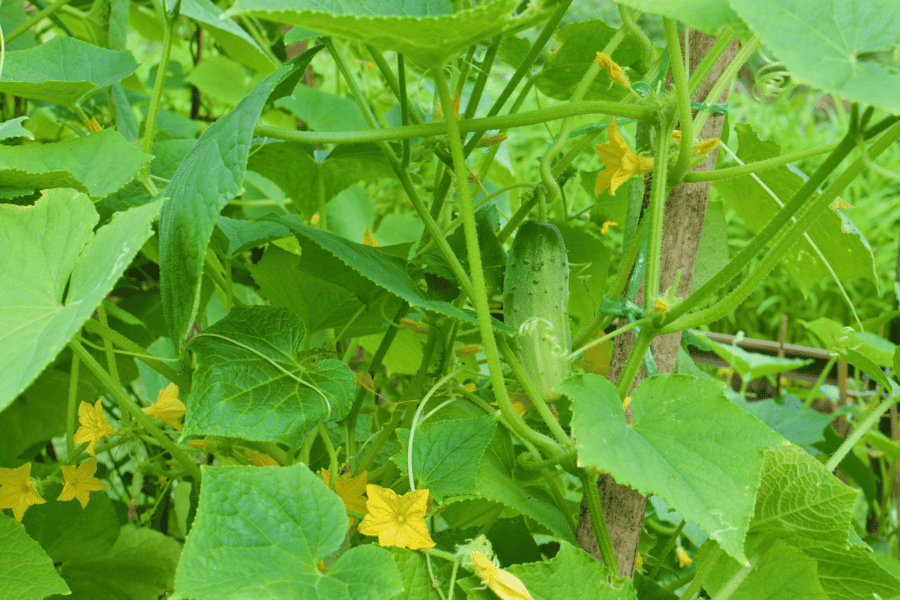White spots on cucumber leaves can be a sign of powdery mildew, a fungal disease that can affect a variety of plants. Powdery mildew appears as white or grayish spots on the leaves, stems, and even fruits of the plant. It can cause the leaves to become distorted and eventually die off, leading to reduced yields.
If you notice white spots on your cucumber leaves, it is important to act quickly to prevent the spread of powdery mildew. There are several treatment options available, including neem oil, horticultural oil, and homemade baking soda solutions. In severe cases, a chemical fungicide may be necessary. It is also important to practice good gardening practices, such as spacing your plants properly and avoiding over-watering, to prevent the spread of powdery mildew.
Table of Contents
Causes of White Spots on Cucumber Leaves
White spots on cucumber leaves are a common problem for gardeners. There are several causes of this issue, including fungal and bacterial infections, environmental factors, and pests. In this section, we will explore each of these causes in more detail.
Fungal Infections
Fungal infections are one of the most common causes of white spots on cucumber leaves. The two most common fungal infections are powdery mildew (caused by Podosphaera fuliginea) and downy mildew (caused by Erysiphe cichoracearum). Powdery mildew appears as white spots on the upper surface of the leaves, while downy mildew appears as yellow spots on the lower surface of the leaves. Both of these infections thrive in high humidity, shady conditions, and poor air circulation.
Bacterial Infections
Bacterial infections, such as angular leaf spot, can also cause white spots on cucumber leaves. Angular leaf spot appears as white spots with yellow halos on the leaves. This infection is spread through water droplets and can survive in soil for up to two years.
Environmental Factors
Environmental factors can also cause white spots on cucumber leaves. Excessive moisture, high humidity, and poor air circulation can all contribute to fungal and bacterial infections. Direct sunlight can help prevent fungal infections, as the spores struggle in full sun. Temperature fluctuations can also stress the plant and make it more susceptible to infections.
Pests
Pests, such as spider mites and thrips, can also cause white spots on cucumber leaves. Spider mites appear as small white or yellow spots on the leaves, while thrips cause white streaks on the leaves. Both pests feed on the sap of the plant and can cause significant damage if left untreated.
In conclusion, there are several causes of white spots on cucumber leaves, including fungal and bacterial infections, environmental factors, and pests. Gardeners should take steps to prevent these issues by providing adequate air circulation, avoiding excessive moisture, and monitoring for pests. If an infection does occur, prompt treatment is necessary to prevent further damage to the plant.

Symptoms of White Spots on Cucumber Leaves
White spots on cucumber leaves are a common symptom of powdery mildew, a fungal disease that can affect the growth and yield of cucumber plants. The first sign of powdery mildew is the appearance of white, powdery-like spots on the underside of older leaves. Later, the characteristic white spots will occur on upper leaf surfaces.
As the disease progresses, the leaves may turn yellow and eventually die, leading to stress on the plant and reduced yield. In severe cases, the entire plant can become stunted, with fallen leaves and a wilted appearance.
In addition to powdery mildew, white spots on cucumber leaves can also be caused by other fungal diseases, such as scab. Scab can cause brown, angular lesions on the leaves, often with yellow chlorotic halos. Young spots are water-soaked and older spots have holes in the center. Stems, petioles, and fruits develop water-soaked lesions that become covered with a white crust.
It is important to identify the cause of white spots on cucumber leaves in order to properly treat the problem. If the cause is powdery mildew, treatment can include removing infected leaves, improving air circulation around the plants, and applying a fungicide. Organic options include neem oil, baking soda, and milk sprays.
Prevention is also key in avoiding white spots on cucumber leaves. Proper spacing between plants, avoiding overhead watering, and removing diseased plant material can all help prevent the spread of powdery mildew and other fungal diseases.
Preventing and Treating White Spots on Cucumber Leaves
When it comes to white spots on cucumber leaves, prevention is the best approach. However, if your plants are already infected, there are several treatments that can help to control the disease. Here, we’ll cover prevention strategies and treatment options for white spots on cucumber leaves.
Prevention
Preventing white spots on cucumber leaves starts with proper plant spacing and air circulation. Cucumber plants should be spaced at least 12 inches apart to allow for proper air circulation. This helps to prevent the buildup of moisture, which can lead to fungal growth. Additionally, pruning can help to improve air circulation and prevent the spread of disease.
Watering is also an important factor in preventing white spots on cucumber leaves. Overhead watering should be avoided, as this can promote the growth of fungal spores. Instead, water at the base of the plant, and avoid getting the leaves wet.
Sunlight exposure is crucial for preventing white spots on cucumber leaves. Cucumber plants should receive at least 6 hours of sun exposure each day. This helps to keep the leaves dry and prevent the growth of powdery mildew.
Organic Treatments
If your cucumber plants are already infected with white spots, there are several organic treatments that can help to control the disease. Neem oil, baking soda and water, and milk are all effective treatments for powdery mildew.
Neem oil is a natural fungicide that can help to control the growth of fungal spores. Baking soda and water can also be used to control powdery mildew. Simply mix 1 tablespoon of baking soda with 1 quart of water, and spray the solution onto the affected leaves.
Milk is another effective treatment for powdery mildew. Mix 1 part milk with 9 parts water, and spray the solution onto the affected leaves.
Chemical Fungicides
Chemical fungicides can also be used to treat white spots on cucumber leaves. However, it’s important to choose a fungicide that is appropriate for cucumbers and powdery mildew. Sulfur and horticultural oil are both effective fungicides for powdery mildew.
Resistant Varieties
Planting resistant cucumber varieties is another effective way to prevent white spots on cucumber leaves. Disease-resistant varieties are available that are less susceptible to powdery mildew. When selecting cucumber varieties, look for those that are resistant to powdery mildew.
Treating Infected Plants
If your cucumber plants are already infected with white spots, there are several steps you can take to control the disease. Removing infected leaves can help to prevent the spread of disease. Additionally, trellising can help to improve air circulation and prevent the growth of powdery mildew.
Chemical fungicides can also be used to control the disease. However, it’s important to follow the instructions carefully and use the appropriate fungicide for cucumbers and powdery mildew. Disinfecting pruning tools between uses can also help to prevent the spread of disease.
Impact on Cucumber Production
White spots on cucumber leaves can have a significant impact on cucumber production. Powdery mildew, the most common cause of white spots on cucumber leaves, can reduce fruit production, affect fruit size, and even lead to plant death in severe cases.
When powdery mildew infects cucumber leaves, it can cause the leaves to yellow and wither, reducing the plant’s ability to photosynthesize and produce energy. This can lead to reduced fruit production and smaller fruit size. In severe cases, the leaves may fall off, leaving the fruit exposed to the sun and making it more susceptible to sunscald.
In addition to the direct impact on cucumber plants, powdery mildew can also affect pollinators. Bees and other pollinators may be less likely to visit infected plants, reducing the chances of successful pollination and fruit production.
Powdery mildew can also reduce the overall health of cucumber plants, making them more susceptible to other diseases and pests. This can further impact fruit production and quality.
To minimize the impact of powdery mildew on cucumber production, it is important to catch the disease early and take steps to control its spread. This can include removing infected leaves, increasing air circulation around plants, and applying fungicides when necessary. Regular monitoring and maintenance can help ensure healthy cucumber plants and a successful harvest.
Frequently Asked Questions
How Do You Get Rid of White Spots on Cucumber Leaves?
To get rid of white spots on cucumber leaves, it is important to identify the underlying cause. If the spots are caused by powdery mildew, a fungal infection, then it is recommended to treat the plant with a fungicide. However, if the spots are caused by other factors such as pests or environmental stress, then addressing those issues may be necessary.
Why Is There White Spots on My Cucumber Leaves?
White spots on cucumber leaves are usually caused by powdery mildew, a fungal infection that thrives in warm and humid conditions. However, other factors such as pests, nutrient deficiencies, and environmental stress can also cause white spots on cucumber leaves.
What Is the Best Treatment for Powdery Mildew on Cucumbers?
The best treatment for powdery mildew on cucumbers is to apply a fungicide that is specifically designed to treat powdery mildew. Additionally, it is important to ensure that the plant is receiving adequate air circulation and that the leaves are not wet for extended periods of time.
How Do You Treat White Spots on Leaves?
Treating white spots on leaves depends on the underlying cause. If the spots are caused by powdery mildew, then a fungicide may be necessary. However, if the spots are caused by pests or environmental stress, then addressing those issues may be necessary.
What Causes White Spots on Cucumber Leaves?
White spots on cucumber leaves are usually caused by powdery mildew, a fungal infection that thrives in warm and humid conditions. However, other factors such as pests, nutrient deficiencies, and environmental stress can also cause white spots on cucumber leaves.
Are White Spots on Cucumber Leaves Harmful?
While white spots on cucumber leaves are unsightly, they are not usually harmful to the plant. However, if left untreated, powdery mildew can spread and cause significant damage to the plant. Additionally, other factors such as pests and environmental stress can weaken the plant and make it more susceptible to other diseases.
Last Updated on June 16, 2023 by Gustaf Johansson




